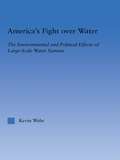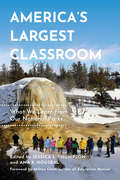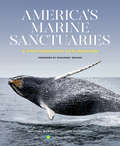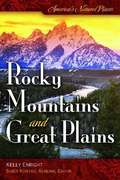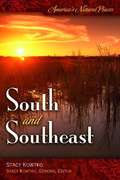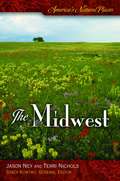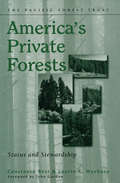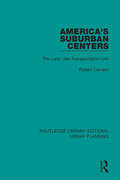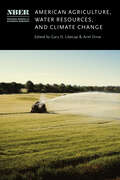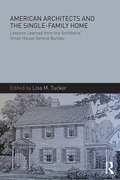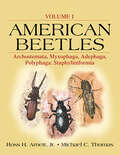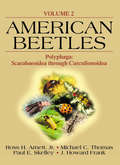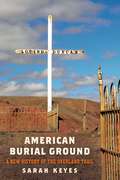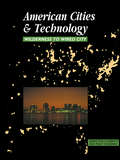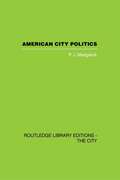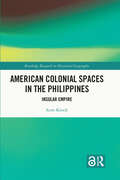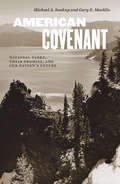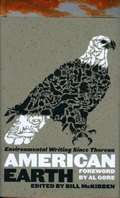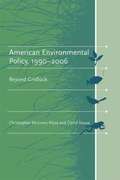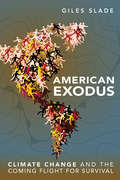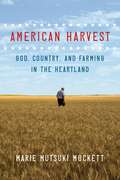- Table View
- List View
America's Fight Over Water: The Environmental and Political Effects of Large-Scale Water Systems (Studies in American Popular History and Culture)
by Kevin WehrThis book inquires into the relations between society and its natural environment by examining the historical discourse around several cases of state building in the American West: the construction of three high dams from 1928 to 1963.
America's Great Storm: Leading through Hurricane Katrina
by Haley BarbourWhen Hurricane Katrina hit Mississippi on August 29, 2005, it unleashed the costliest natural disaster in American history, and the third deadliest. Haley Barbour had been Mississippi's governor for only twenty months when he assumed responsibility for guiding his pummeled, stricken state's recovery and rebuilding efforts. America's Great Storm is not only a personal memoir of his role in that recovery, but also a sifting of the many lessons he learned about leadership in a time of massive crisis. For the book, the authors interviewed more than forty-five key people involved in helping Mississippi recover, including local, state, and federal officials as well as private citizens who played pivotal roles in the weeks and months following Katrina's landfall. In addition to covering in detail the events of September and October 2005, chapters focus on the special legislative session that allowed casinos to build on shore; the role of the recovery commission chaired by Jim Barksdale; a behind-the-scenes description of working with Congress to pass an unprecedented, multi-billion-dollar emergency disaster assistance appropriation; and the enormous roles played by volunteers in rebuilding the entire housing, transportation, and education infrastructure of South Mississippi and the Gulf Coast. A final chapter analyzes the leadership skills and strategies Barbour employed on behalf of the people of his state, observations that will be valuable to anyone tasked with managing in a crisis.
America's Largest Classroom: What We Learn from Our National Parks
by Jessica L. ThompsonOver the past 100 years, visitor learning at America’s national parks has grown and evolved. Today, there are over 400 National Park Service (NPS) sites, representing over eighty million acres. Sites exist in every US state and territory and are located on land, at sea, in remote areas, and in major urban centers. Every year, more than 300 million people visit national parks, and several million of them are children engaged in one of many educational programs hosted by the NPS.America’s Largest Classrooms offers insight and practical advice for improving educational outreach at national parks as well as suggestions for classroom educators on how to meaningfully incorporate parks into their curricula. Via a wide collection of case studies—ranging from addressing inclusivity at parks and public lands to teaching about science and social issues—this book illustrates innovations and solutions that will be of interest to nature interpreters, outdoor educators, and policy makers, as well as professors in the sciences writ large.
America's Marine Sanctuaries: A Photographic Exploration
by NAT'L MARINE SANCTUARY FDNAn extraordinary illustrated overview of the National Marine Sanctuary System and a guide to its fourteen protected underwater locationsAmerica's Marine Sanctuaries tells the story of fourteen underwater places so important they are under special protection, together forming the US National Marine Sanctuary System. These sanctuaries, spanning more than 620,000 square miles and ranging from the Florida Keys to the Great Lakes and to the Hawaiian Islands, are critical and breathtaking marine habitats that provide homes to endangered and threatened species. They also preserve America's rich maritime heritage and act as living laboratories for science, research, education, and conservation, offering outdoor recreation experiences for all ages. Through 175 full-color photographs and lively narrative, America's Marine Sanctuaries showcases each of the marine sanctuaries and the creatures that live there, from whales and manatees to Hawaiian monk seals and Laysan ducks, as well as sunken ships from the Ghost Fleet and USS Monitor to Shipwreck Alley. The book underscores how marine sanctuaries have shaped the nation's development, survival, and identity, and celebrates these protected underwater treasures for all they can tell us about our communities, our country, and our world.
America's Natural Places: Pacific And West
by Methea K. SappFrom Alaska As Arctic National Wildlife Refuge to the Milnes and Prairie Preserve of New Mexico, this volume provides a snapshot of the most spectacular and important natural places in the western United States.
America's Natural Places: Rocky Mountains And Great Plains
by Kelly EnrightFrom Rocky Mountain National Park in Colorado to the Tallgrass Prairie National Preserve in Kansas, this volume provides a snapshot of the most spectacular and important natural places in the Great Plains and Rocky Mountains.
America's Natural Places: South And Southeast
by Stacy S. KowtkoFrom the Texas Blackland Prairies to the Middle Atlantic Coastal Plain of the Carolinas, this volume provides a snapshot of the most spectacular and important natural places in the southern United States.
America's Natural Places: The Midwest
by Jason Ney Terri NicholsFrom Iowa's Decorah Ice Cave to the Kitty Todd Nature Preserve in Ohio, this volume provides a snapshot of the most spectacular and important natural places in the Midwestern United States.
America's Neighborhood Bats: Understanding and Learning to Live in Harmony with Them (Revised Edition)
by Merlin D. TuttleA guide to these frequently misunderstood animals that dispels unnecessary fears and encourages an appreciation of bats and their conservation needs. Since its publication in 1988, America&’s Neighborhood Bats has changed the way we look at bats by underscoring their harmless and beneficial nature. In this revised edition, Merlin Tuttle offers bat aficionados the most up-to-date bat facts, including a wealth of new information on attracting bats and building bat houses and a revamped key to the identification of common North American species. The easy-to-understand text, clear illustrations, and spectacular color photographs make this the perfect bat book for the general reader, as well as an invaluable resource for professionals who field questions from the public. Those who provide advice at health and animal control departments, museums, zoos, and nature centers will find it especially useful.
America's Private Forests: Status And Stewardship
by John Gordon Laurie A. Wayburn Constance Best Pacific Forest TrustNearly 430 million acres of forests in the United States are privately owned, but the viability, and indeed the very existence, of these forests is increasingly threatened by population growth, sprawling urbanization, and patchwork development. Scientists, policymakers, and community leaders have begun to recognize the vital role of private forests in providing society with essential goods and services, from sustainable timber supplies to clean water. Yet despite the tremendous economic and ecological importance of private forests, information about their status and strategies for their protection have been in short supply.America's Private Forests addresses that shortcoming, presenting extensive data gathered from diverse sources and offering a concise overview of the current status of privately owned forests in the United States. As well as describing the state of private forests, the book sets forth detailed information on a wide range of approaches to conservation along with an action agenda for implementing those strategies likely to be most effective.Based on extensive research of existing literature as well as interviews and consultation with leading forestry and conservation experts, America's Private Forests is a unique sourcebook that offers a solid basis for discussion of threats to private forests along with an invaluable compendium of potential solutions. It will serve as an invaluable reference for those working to conserve and steward forest resources, including forest owners and their consultants, conservation organizations, and agency personnel, as well as researchers and students involved with issues of forestry, biodiversity, land use, and conservation.
America's Suburban Centers: The Land Use-Transportation Link (Routledge Library Editions: Urban Planning #6)
by Robert CerveroOriginally published in 1989, America’s Suburban Centers looks at how America’s suburban workplaces are being increasingly designed for automobiles rather than people. The emergence of sprawling office complexes devoid of housing, shops and other facilities is giving rise to regional congestion problems because of the ever-greater dependence on automobiles. This book argues that the low-density, single-use, and non-integrated character of America’s suburban centers is a root cause of declining levels of mobility and worsening traffic congestion.
American Agriculture, Water Resources, and Climate Change (National Bureau of Economic Research Conference Report)
by Gary D. Libecap and and Ariel DinarA collection of the most advanced and authoritative agricultural-economic research in the face of increasing water scarcity. Agriculture has been critical in the development of the American economy. Except in parts of the western United States, water access has not been a critical constraint on agricultural productivity, but with climate change, this may no longer be the case. This volume highlights new research on the interconnections between American agriculture, water resources, and climate change. It examines climatic and geologic factors that affect the agricultural sector and highlights historical and contemporary farmer responses to varying conditions and water availability. It identifies the potential effects of climate change on water supplies, access, agricultural practices, and profitability, and analyzes technological, agronomic, management, and institutional adjustments. Adaptations such as new crops, production practices, irrigation technologies, water conveyance infrastructure, fertilizer application, and increased use of groundwater can generate both social benefits and social costs, which may be internalized with various institutional innovations. Drawing on both historical and present experiences, this volume provides valuable insights into the economics of water supply in American agriculture as climate change unfolds.
American Architects and the Single-Family Home: Lessons Learned from the Architects' Small House Service Bureau
by Lisa M. TuckerAmerican Architects and the Single-Family Home explains how a small group of architects started the Architects’ Small House Service Bureau in 1919 and changed the course of twentieth-century residential design for the better. Concepts and principles they developed related to public spaces, private spaces, and service spaces for living; details about the books they published to promote good design; as well as new essays from contemporary practitioners will inspire your own designs. More than 200 black and white images.
American Beetles, Volume I: Archostemata, Myxophaga, Adephaga, Polyphaga: Staphyliniformia
by Jr. Ross H. Arnett Michael C. ThomasA thorough update of Arnett's The Beetles of the United States, American Beetles, Volumes I and II cover the genera of beetles that occur in Alaska, Canada, and the contiguous United States. Built on the foundation of the original work and almost completely rewritten with contributions from more than 60 coleopterists, these volumes describe each fa
American Beetles, Volume II: Polyphaga: Scarabaeoidea through Curculionoidea
by J. Howard Frank Ross H. Arnett Michael C. Thomas Paul E. SkelleyExperts offer the most sweeping reference available on the subject of North American beetles. Their rigorous standards for the presentation of data create a concise, useful format that is consistent throughout the book. This is the resource of choice for quick, accurate, and easily accessible information.
American Burial Ground: A New History of the Overland Trail (America in the Nineteenth Century)
by Sarah KeyesIn popular mythology, the Overland Trail is typically a triumphant tale, with plucky easterners crossing the Plains in caravans of covered wagons. But not everyone reached Oregon and California. Some 6,600 migrants perished along the way and were buried where they fell, often on Indigenous land. As historian Sarah Keyes illuminates, their graves ultimately became the seeds of U.S. expansion.By the 1850s, cholera epidemics, ordinary diseases, and violence had remade the Trail into an American burial ground that imbued migrant deaths with symbolic power. In subsequent decades, U.S. officials and citizens leveraged Trail graves to claim Native ground. Meanwhile, Indigenous peoples pointed to their own sacred burial grounds to dispute these same claims and maintain their land. These efforts built on anti-removal campaigns of the 1820s and 30s, which had established the link between death and territorial claims on which the significance of the Overland Trail came to rest.In placing death at the center of the history of the Overland Trail, American Burial Ground offers a sweeping and long overdue reinterpretation of this historic touchstone. In this telling, westward migration was a harrowing journey weighed down by the demands of caring for the sick and dying. From a tale of triumph comes one of struggle, defined as much by Indigenous peoples’ actions as it was by white expansion. And, finally, from a migration to the Pacific emerges instead a trail of graves. Graves that ultimately undergirded Native dispossession.
American Cities and Technology: Wilderness to Wired city (Cities and Technology)
by Gerrylynn K. Roberts Philip SteadmanDesigned to be used on its own or as a companion volume to the American Cities and Technology textbook. Chronologically, this volume ranges from the earliest technological dimensions of Amerindian settlements to the 'wired city' concept of the 1960s and internet communications of the 1990s.Its focus extends beyond the US to include telecomunications in Asian cities in the late 20th century. The topics covered:* the rise of the skyscraper*the coming of the automobile age* relations between private and public transport* the development of infrastructural technologies and systems* the implications of electronic communications* the emergence of city planning.
American City Politics (Library Of Political Studies)
by Peter J MadgwickThis book begins with an introductory outline of the structure of the city politics of the United States. There is a study of the city in the federal system, including the politics of feudal aid. This is followed by four case studies: the political roles of mayor, manager, boss and adminstrator-entrepreneur in the city. Madgwick concludes with some comparative reflections indicating the significance of this study for British local government. This book was first published in 1970.
American Colonial Spaces in the Philippines: Insular Empire (Routledge Research in Historical Geography)
by Scott KirschAmerican Colonial Spaces in the Philippines tells the story of U.S. colonialists who attempted, in the first decades of the twentieth century, to build an enduring American empire in the Philippines through the production of space. From concrete interventions in infrastructure, urban planning, and built environments to more abstract projects of mapping and territorialization, the book traces the efforts of U.S. Insular Government agents to make space for empire in the Philippines through forms of territory, map, landscape, and road, and how these spaces were understood as solutions to problems of colonial rule. Through the lens of space, the book offers an original history of a highly transformative, but largely misunderstood or forgotten, imperial moment, when the Philippine archipelago, made up of thousands of islands and an ethnically and religiously diverse population of more than seven million, became the unlikely primary setting for U.S. experimentation with formal colonial governance. Telling that story around key figures including Cameron Forbes, Daniel Burnham, Dean Worcester, and William Howard Taft, the book provides distinctive chapters dedicated to spaces of territory (sovereignty), maps (knowledge), landscape (aesthetics), and roads (circulation), suggesting new and integrative historical geographical approaches. This book will be of interest to students of Cultural, Historical, and Political Geography, American History, American Studies, Philippine Studies, Southeast Asia/Philippines; Asian Studies as well as general readers interested in these areas.
American Colonial Spaces in the Philippines: Insular Empire (Routledge Research in Historical Geography)
by Scott KirschAmerican Colonial Spaces in the Philippines tells the story of U.S. colonialists who attempted, in the first decades of the twentieth century, to build an enduring American empire in the Philippines through the production of space. From concrete interventions in infrastructure, urban planning, and built environments to more abstract projects of mapping and territorialization, the book traces the efforts of U.S. Insular Government agents to make space for empire in the Philippines through forms of territory, map, landscape, and road, and how these spaces were understood as solutions to problems of colonial rule.Through the lens of space, the book offers an original history of a highly transformative, but largely misunderstood or forgotten, imperial moment, when the Philippine archipelago, made up of thousands of islands and an ethnically and religiously diverse population of more than seven million, became the unlikely primary setting for U.S. experimentation with formal colonial governance. Telling that story around key figures including Cameron Forbes, Daniel Burnham, Dean Worcester, and William Howard Taft, the book provides distinctive chapters dedicated to spaces of territory (sovereignty), maps (knowledge), landscape (aesthetics), and roads (circulation), suggesting new and integrative historical geographical approaches.This book will be of interest to students of Cultural, Historical, and Political Geography, American History, American Studies, Philippine Studies, Southeast Asia/Philippines; Asian Studies as well as general readers interested in these areas.The Open Access version of this book, available at http://www.taylorfrancis.com, has been made available under a Creative Commons [Attribution-Non Commercial-No Derivatives (CC BY-NC-ND)] 4.0 license.
American Covenant: National Parks, Their Promise, and Our Nation's Future
by Gary E Machlis Michael A SoukupAn intimate and candid account of our national parks and their strengths, vulnerabilities, and essential role in American life Part memoir, part critique, and paean to the value of national parks, American Covenant distills the experience and insights from two long careers in conservation. Michael A. Soukup and Gary E. Machlis show how the national parks are essential to maintaining the essence of our national heritage, and key to America&’s future in a changing climate and political landscape. Sharing real-world examples of both victories and defeats in protecting national parks, this candid, thoughtful book reminds us that the national parks are a promise—a covenant—within and between generations of Americans. The book is also a call to revitalize, reconstitute, reconfigure, and reform the National Park Service, which the authors believe is governed too much by outdated management practices and politics instead of a foundation of expertise and science.
American Earth: Environmental Writing Since Thoreau
by Al Gore Bill MckibbenAs America and the world grapple with the consequences of global environmental change, writer and activist Bill McKibben offers this unprecedented, provocative, and timely anthology, gathering the best and most significant American environmental writing from the last two centuries. Classics of the environmental imagination'the essays of Henry David Thoreau, John Muir, and John Burroughs; Aldo Leopold's A Sand County Almanac; Rachel Carson's Silent Spring are set against the inspiring story of an emerging activist movement, as revealed by newly uncovered reports of pioneering campaigns for conservation, passages from landmark legal opinions and legislation, and searing protest speeches. Here are some of America's greatest and most impassioned writers, taking a turn toward nature and recognizing the fragility of our situation on earth and the urgency of the search for a sustainable way of life. Thought-provoking essays on overpopulation, consumerism, energy policy, and the nature of "nature" join ecologists' memoirs and intimate sketches of the habitats of endangered species. The anthology includes a detailed chronology of the environmental movement and American environmental history, as well as an 80-page color portfolio of illustrations.
American Environmental Policy, 1990-2006: Beyond Gridlock
by Christopher Mcgrory Klyza David J. SousaThe "golden era" of American environmental law making, between 1964 and 1980, saw twenty-two pieces of major environmental legislation passed by bipartisan majorities in Congress and signed into law by presidents of both parties.
American Exodus
by Giles SladeAs temperatures rise, declines in agricultural production and freshwater supply will diminish US carrying capacity by 2/3, and rising sea levels will impact the country's most densely populated regions. A frightening survey of what's to come, American Exodus argues that mankind can survive the coming century of climate chaos if we act quickly to preserve our shelter of last resort.
American Harvest: God, Country, and Farming in the Heartland
by Marie Mutsuki MockettAn epic story of the American wheat harvest, the politics of food, and the culture of the Great PlainsFor over one hundred years, the Mockett family has owned a seven-thousand-acre wheat farm in the panhandle of Nebraska, where Marie Mutsuki Mockett’s father was raised. Mockett, who grew up in bohemian Carmel, California, with her father and her Japanese mother, knew little about farming when she inherited this land. Her father had all but forsworn it.In American Harvest, Mockett accompanies a group of evangelical Christian wheat harvesters through the heartland at the invitation of Eric Wolgemuth, the conservative farmer who has cut her family’s fields for decades. As Mockett follows Wolgemuth’s crew on the trail of ripening wheat from Texas to Idaho, they contemplate what Wolgemuth refers to as “the divide,” inadvertently peeling back layers of the American story to expose its contradictions and unhealed wounds. She joins the crew in the fields, attends church, and struggles to adapt to the rhythms of rural life, all the while continually reminded of her own status as a person who signals “not white,” but who people she encounters can’t quite categorize.American Harvest is an extraordinary evocation of the land and a thoughtful exploration of ingrained beliefs, from evangelical skepticism of evolution to cosmopolitan assumptions about food production and farming. With exquisite lyricism and humanity, this astonishing book attempts to reconcile competing versions of our national story.
